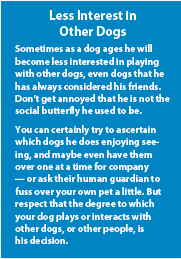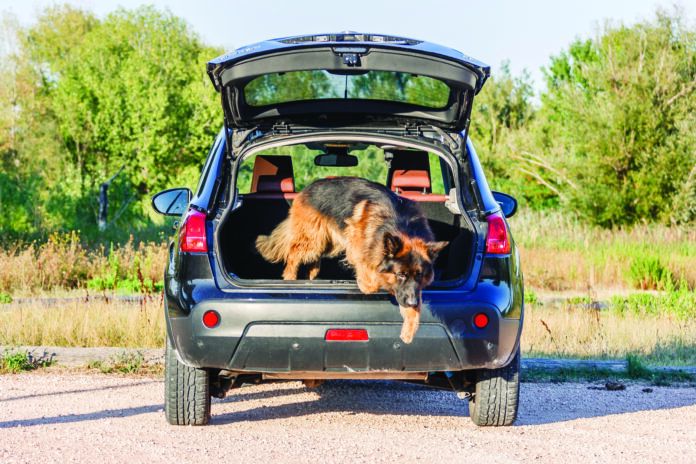Your dog has always jumped into the car excitedly, but now he won’t budge unless you give him a boost. Yet he still loves running around like crazy. Why is he insisting that you help lift him when he’s still
very active?
Or you call him from the next room to go for a walk, but he doesn’t always respond these days and you often have to bring the collar and leash to him rather than vice versa. Why is he making you wait on him?
Don’t be too quick to get annoyed. There’s a fair chance that as he ages, your dog is losing some of his agility as well as some of his sensory acuity. The changes can be easy to miss, because they come gradually enough that they seem like new behavioral idiosyncrasies rather than a genuine slowing down. But even small dogs are generally considered “senior” by the time they are seven years old, according to the American Veterinary Medical Association. That provides a lot of time for the aging process to play out. Herein, some signs to look for.
Mobility. While your dog may still have a lot of speed, his joints may no longer be as supple as they once were, making it difficult to maneuver up and down. That’s why he might need your help climbing into the car. You might also see that your pet naps on the floor more often than his favorite couch or chair. It could be for the same reason: jumping up has become too hard,
or painful.
Hearing. If your dog has been taught to come to you when called but no longer does, or only does intermittently, there’s a good chance it’s not because he has chosen to misbehave. Hearing often becomes less acute with age. It’s for that reason that your dog also may not heed your cue to come have his leash put on at the door, or may not return to you when the romp in the park is over and it’s time to get back to the car.
does, or only does intermittently, there’s a good chance it’s not because he has chosen to misbehave. Hearing often becomes less acute with age. It’s for that reason that your dog also may not heed your cue to come have his leash put on at the door, or may not return to you when the romp in the park is over and it’s time to get back to the car.
Vision. Just like with older people, older dogs are subject to cataracts, macular degeneration, and glaucoma, all of which can interfere with keen vision and make a dog less likely to engage in his habit of looking out the door and barking at things you can’t see.
Vocalizations. Just like any being whose life is hemmed in by diminished mobility, hearing, vision, or all three, your aging dog may feel particularly insecure and vulnerable. That’s even more true for dogs experiencing geriatric aches and pains. Thus, if your dog starts whimpering or barking more, it’s not to drive you crazy. It’s to alert you to the fact that he doesn’t feel well or isn’t able to accomplish something for himself that he used to be able to. Rather than respond to your pet’s vocalizations with frustration, go over and reassure him and see if you can figure out what’s wrong. Sometimes it might even be something as simple as he’s thirsty and is asking you to bring him his water bowl. Knowing that you’re there for him, even if you can’t figure out what’s wrong in the moment, will help decrease his stress level.
Cognitive changes. Sometimes what seems like an inability to hear or see well is about cognitive decline. The dog is no longer attending to his surroundings in the way he once did.
Medical solutions often available
If you see your dog behaving differently as he moves further into older age, do not diagnose what’s going on by yourself. A lot of times, a change in behavior could result from any one of a number of causes. Also don’t assume that it’s just part of life and that nothing can be done. That’s very important. There’s often plenty that can be done.
For instance, a dog with decreased mobility may find pain relief — and then a greater ability to move about — with various drugs and supplements that your pet’s veterinarian can discuss with you. In some cases, a surgery or massage therapy can relieve pain — or even correct a problem.
When it comes to hearing, sometimes a good ear cleaning at the doctor’s office is what’s needed, followed by periodic cleanings at home. A buildup of debris in the ear can really muffle sound. If your dog truly is losing his hearing, you can teach him a few hand signals for “Come,” “Wait,” “Food,” “Walk,” and so on. (A repeated turning over of your hand means it’s time for a walk.)
As for vision, dogs can be helped with cataract surgery, if need be, in addition to various medical therapies for macular degeneration or glaucoma. The vet may also diagnose something less common in an eye that requires attention. Additionally, she might ask salient questions to be able to help you determine whether your dog is beginning to undergo cognitive changes that could signal the canine version of Alzheimer’s. That way, at least you will know what’s ahead of you and how to make your dog feel more comfortable as his cognition gets away from him.





